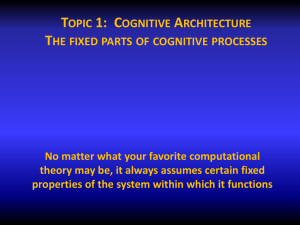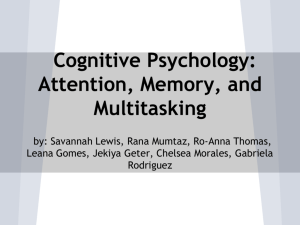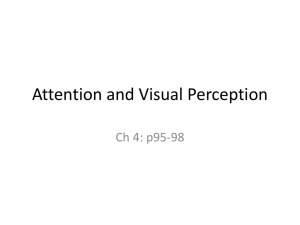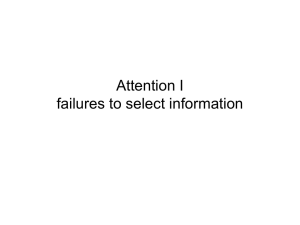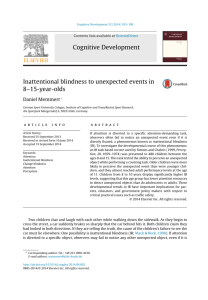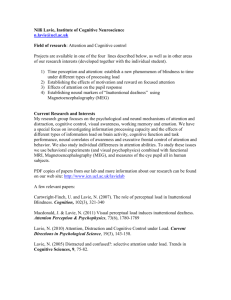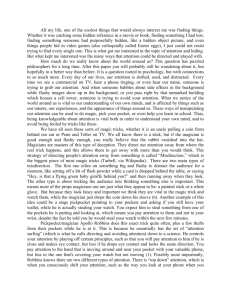urn_nbn_fi_jyu-20
advertisement
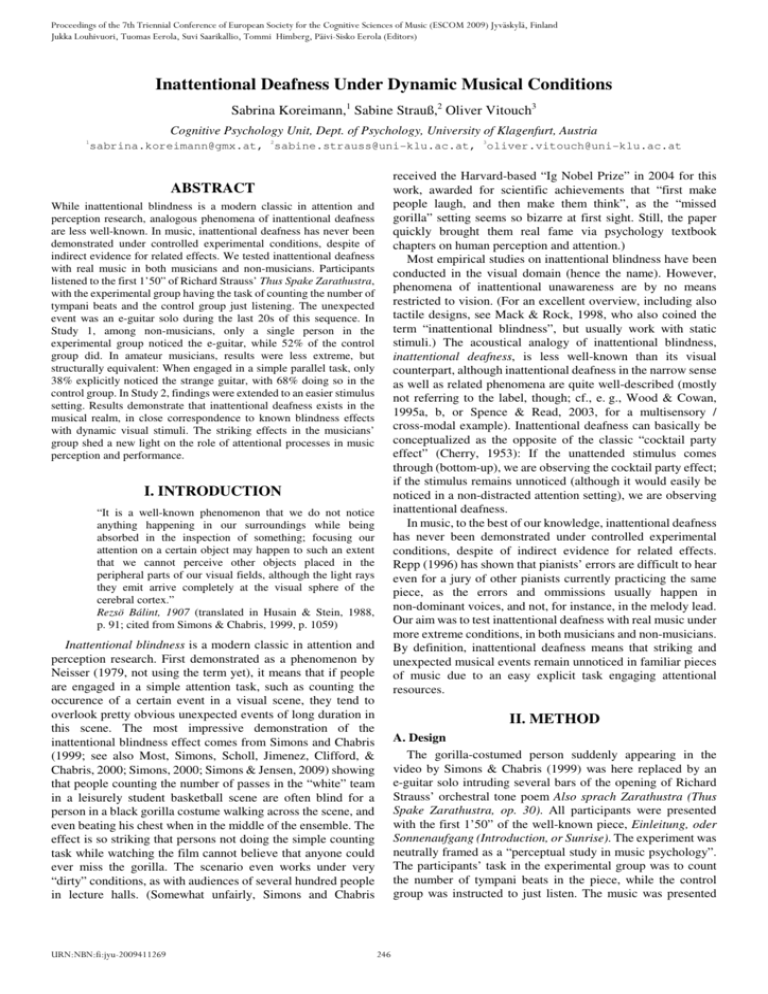
Proceedings of the 7th Triennial Conference of European Society for the Cognitive Sciences of Music (ESCOM 2009) Jyväskylä, Finland
Jukka Louhivuori, Tuomas Eerola, Suvi Saarikallio, Tommi Himberg, Päivi-Sisko Eerola (Editors)
Inattentional Deafness Under Dynamic Musical Conditions
Sabrina Koreimann,1 Sabine Strauß,2 Oliver Vitouch3
Cognitive Psychology Unit, Dept. of Psychology, University of Klagenfurt, Austria
1
2
3
sabrina.koreimann@gmx.at, sabine.strauss@uni-klu.ac.at, oliver.vitouch@uni-klu.ac.at
received the Harvard-based “Ig Nobel Prize” in 2004 for this
work, awarded for scientific achievements that “first make
people laugh, and then make them think”, as the “missed
gorilla” setting seems so bizarre at first sight. Still, the paper
quickly brought them real fame via psychology textbook
chapters on human perception and attention.)
Most empirical studies on inattentional blindness have been
conducted in the visual domain (hence the name). However,
phenomena of inattentional unawareness are by no means
restricted to vision. (For an excellent overview, including also
tactile designs, see Mack & Rock, 1998, who also coined the
term “inattentional blindness”, but usually work with static
stimuli.) The acoustical analogy of inattentional blindness,
inattentional deafness, is less well-known than its visual
counterpart, although inattentional deafness in the narrow sense
as well as related phenomena are quite well-described (mostly
not referring to the label, though; cf., e. g., Wood & Cowan,
1995a, b, or Spence & Read, 2003, for a multisensory /
cross-modal example). Inattentional deafness can basically be
conceptualized as the opposite of the classic “cocktail party
effect” (Cherry, 1953): If the unattended stimulus comes
through (bottom-up), we are observing the cocktail party effect;
if the stimulus remains unnoticed (although it would easily be
noticed in a non-distracted attention setting), we are observing
inattentional deafness.
In music, to the best of our knowledge, inattentional deafness
has never been demonstrated under controlled experimental
conditions, despite of indirect evidence for related effects.
Repp (1996) has shown that pianists’ errors are difficult to hear
even for a jury of other pianists currently practicing the same
piece, as the errors and ommissions usually happen in
non-dominant voices, and not, for instance, in the melody lead.
Our aim was to test inattentional deafness with real music under
more extreme conditions, in both musicians and non-musicians.
By definition, inattentional deafness means that striking and
unexpected musical events remain unnoticed in familiar pieces
of music due to an easy explicit task engaging attentional
resources.
ABSTRACT
While inattentional blindness is a modern classic in attention and
perception research, analogous phenomena of inattentional deafness
are less well-known. In music, inattentional deafness has never been
demonstrated under controlled experimental conditions, despite of
indirect evidence for related effects. We tested inattentional deafness
with real music in both musicians and non-musicians. Participants
listened to the first 1’50” of Richard Strauss’ Thus Spake Zarathustra,
with the experimental group having the task of counting the number of
tympani beats and the control group just listening. The unexpected
event was an e-guitar solo during the last 20s of this sequence. In
Study 1, among non-musicians, only a single person in the
experimental group noticed the e-guitar, while 52% of the control
group did. In amateur musicians, results were less extreme, but
structurally equivalent: When engaged in a simple parallel task, only
38% explicitly noticed the strange guitar, with 68% doing so in the
control group. In Study 2, findings were extended to an easier stimulus
setting. Results demonstrate that inattentional deafness exists in the
musical realm, in close correspondence to known blindness effects
with dynamic visual stimuli. The striking effects in the musicians’
group shed a new light on the role of attentional processes in music
perception and performance.
I. INTRODUCTION
“It is a well-known phenomenon that we do not notice
anything happening in our surroundings while being
absorbed in the inspection of something; focusing our
attention on a certain object may happen to such an extent
that we cannot perceive other objects placed in the
peripheral parts of our visual fields, although the light rays
they emit arrive completely at the visual sphere of the
cerebral cortex.”
Rezsö Bálint, 1907 (translated in Husain & Stein, 1988,
p. 91; cited from Simons & Chabris, 1999, p. 1059)
Inattentional blindness is a modern classic in attention and
perception research. First demonstrated as a phenomenon by
Neisser (1979, not using the term yet), it means that if people
are engaged in a simple attention task, such as counting the
occurence of a certain event in a visual scene, they tend to
overlook pretty obvious unexpected events of long duration in
this scene. The most impressive demonstration of the
inattentional blindness effect comes from Simons and Chabris
(1999; see also Most, Simons, Scholl, Jimenez, Clifford, &
Chabris, 2000; Simons, 2000; Simons & Jensen, 2009) showing
that people counting the number of passes in the “white” team
in a leisurely student basketball scene are often blind for a
person in a black gorilla costume walking across the scene, and
even beating his chest when in the middle of the ensemble. The
effect is so striking that persons not doing the simple counting
task while watching the film cannot believe that anyone could
ever miss the gorilla. The scenario even works under very
“dirty” conditions, as with audiences of several hundred people
in lecture halls. (Somewhat unfairly, Simons and Chabris
URN:NBN:fi:jyu-2009411269
II. METHOD
A. Design
The gorilla-costumed person suddenly appearing in the
video by Simons & Chabris (1999) was here replaced by an
e-guitar solo intruding several bars of the opening of Richard
Strauss’ orchestral tone poem Also sprach Zarathustra (Thus
Spake Zarathustra, op. 30). All participants were presented
with the first 1’50” of the well-known piece, Einleitung, oder
Sonnenaufgang (Introduction, or Sunrise). The experiment was
neutrally framed as a “perceptual study in music psychology”.
The participants’ task in the experimental group was to count
the number of tympani beats in the piece, while the control
group was instructed to just listen. The music was presented
246
Proceedings of the 7th Triennial Conference of European Society for the Cognitive Sciences of Music (ESCOM 2009) Jyväskylä, Finland
Jukka Louhivuori, Tuomas Eerola, Suvi Saarikallio, Tommi Himberg, Päivi-Sisko Eerola (Editors)
not knowing the piece. Thus, the data of N = 47 subjects (age
19-51 years, M = 26 years, 70% female) were finally analyzed
here.
from a digital source via loudspeakers, with the e-guitar’s onset
at 1’16” (lasting for 20s).
Afterwards, methodically following Simons & Chabris
(1999), all participants were successively asked (a) if they had
noticed anything peculiar, (b) if they had noticed any unfitting
instruments or sounds, and (c) if they had noticed the e-guitar. If
they answered any of these questions with “yes”, they were
immediately inquired what exactly had been perceived, how it
had sounded, and when it had happened (beginning, middle, or
end of the sequence).
The counting of the tympani beats was chosen as the
attentive task for the experimental group due to (1) its relative
simplicity, requiring no formal music training, and (2) the
tympani’s spectral distance to the e-guitar, directing attention to
the bass voices of the orchestra. (Remember that the strongest
effect in the gorilla study was observed when the passes in the
team with the white T-shirts had to be counted in order to draw
attention away from the black gorilla costume; cf. Simons &
Jensen, 2009, for effects of task difficulty).
III. RESULTS
A. Study 1 (Main Take)
1) Non-Musicians. The results for the non-musicians
subsample are given in Figure 1. The e-guitar was explicitly
mentioned by just a single person in the experimental group,
while it was spontaneously noticed by 52% (15 out of 29) in the
control group. This between-groups difference, in accordance
with the main hypothesis on inattentional blindness in music, is
significant with χ2 (2) = 18.8, p < .001, and a contingency
coefficient of CC = .50.
B. Materials
The e-guitar improvisations were recorded by a locally
renowned bona fide professional jazz guitar player on a
semi-acoustic guitar, linked to a standard guitar amplifier
(Mesa Boogie, Quad Preamp). They were cut and mixed into a
commercial standard recording of the orchestra piece (Chicago
Symphony Orchestra, Sir Georg Solti, Decca 1994) using the
Samplitude Professional 8.0 software. The two versions, main
take and alternate take, actually used for the experiment were
chosen out of seven different takes which varied in
distinctiveness / embeddedness, loudness, and use of the
bottleneck technique, based on the experimenters’ pre-selective
judgment and a pilot study for task difficulty. Compared to the
main take selected for Study 1, the alternate take (with
bottleneck) selected for Study 2 is clearly less embedded and
therefore has a lower task difficulty. Audio files (MP3) of both
versions are available for download for demonstration purposes
at the following URLs:
http://www.uni-klu.ac.at/psy/cognition/download/zarathustra/
version_1.mp3 [main take, Study 1]
http://www.uni-klu.ac.at/psy/cognition/download/zarathustra/
version_2.mp3 [alternate take, Study 2]
Figure 1. Results in the non-musicians group. Yellow ...
experimental group (counting task), blue ... control group (no
task).
2) Amateur Musicians. In the amateur musicians’ group,
results were less extreme, but structurally equivalent. Figure 2
gives an overview of the experimental data.
C. Sample
A total of 125 subjects initially participated in Study 1, with
6 being excluded post-hoc due to not knowing the piece, 3 due
to hearing impairments, and 1 due to reporting a result of the
counting task (experimental group) more than three standard
deviations apart from the group average (cf. Simons & Chabris,
1999). Hence, the experimental data of N = 115 subjects were
finally analyzed (age 18-63 years, M = 26 years, 64% female).
Of these, n1 = 58 were non-musicians, and n2 = 57 were amateur
musicians (or music students and musicians of higher
qualification) with a minimum of either {7 hours of weekly
instrumental practice during the last 3 or more years} or {3
hours of weekly instrumental practice during the last 5 or more
years}.
In Study 2, performed with the easier alternate take in order
to get additional information about task difficulty effects, all 50
participants were non-musicians, with 3 being excluded due to
URN:NBN:fi:jyu-2009411269
Figure 2. Results in the amateur musicians group. Yellow ...
experimental group (counting task), blue ... control group (no
task).
When engaged in a simple attentive parallel task, only 38%
(11 out of 29) of the amateur musicians did explicitly notice the
247
Proceedings of the 7th Triennial Conference of European Society for the Cognitive Sciences of Music (ESCOM 2009) Jyväskylä, Finland
Jukka Louhivuori, Tuomas Eerola, Suvi Saarikallio, Tommi Himberg, Päivi-Sisko Eerola (Editors)
As shown in Figure 4, effects of task difficulty (inattended
task) are clearly visible. The participants in this experiment
generally performed better, i. e., showed less deafness effects,
than in Study 1. Still, despite the relatively small sample and the
more mixed effects, the treatment factor (counting task vs. no
task) only marginally misses significance with χ2 (2) = 5.6,
p = .060, and CC = .33. If one argues that the hypotheses of all
experiments reported in this paper are clearly directional
(differences are expected in terms of more deafness effects in
the experimental groups and less deafness effects in the control
groups), then it seems feasible to apply one-sided tests of
significance, which would result in pone-sided = .030 here. In any
case, taking the different sample sizes into account, it should be
evident that the inattentional deafness effect does not simply
disappear here, but is gradually moderated by the difficulty of
the attended task (q.e.d).
strange guitar, while 68% (19 out of 28) did in the control
group. Again, the between-groups difference is significant with
χ2 (2) = 6.8, p = .034, and a contingency coefficient of CC =
.33.
3) Expertise-Related Differences. General differences in
performance level between the non-musicians group and the
musicians group are displayed, aggregated across experimental
conditions, in Figure 3.
IV. CONCLUSION
Results demonstrate that inattentional deafness exists in the
musical realm, in close correspondence to known blindness
effects with dynamic visual stimuli (in film and reality settings).
We had expected this for the non-musicians group, but were
quite surprised to find that the effect holds, albeit to a more
moderate degree, even for a group of amateur musicians (also
including music students and other persons of higher musical
qualifications). This deafness effect in domain-specific experts
seems particulary revealing, since the like has not been done
before in the context of inattentional blindness – there is no
apparent parallel to this in the sense of “visual experts”,
although students of film direction may be an interesting choice
here.
Another specific feature of the studies presented is that
inattentional unawareness effects have been demonstrated
under dynamic conditions, and with real-life musical stimulus
material. Therefore, the ecological validity of these results is
more satisfying than with earlier studies, especially from the
visual domain, using static and experimentally simplified
stimuli (cf. the work of Simons & Levin, 1998, who brilliantly
succeeded at demonstrating person-related change blindness
effects in a real-life setting on a university campus).
Altogether, results show close correspondence to the
findings from the visual domain, and are just as perplexing:
Subjects tend to completely miss an e-guitar improvisation in a
classical piece of music under simple conditions of attentional
distraction. The striking effects also in the amateur musicians’
group shed a new light on the role of attentional processes in
music perception and performance.
Figure 3. General performance differences of non-musicians vs.
amateur musicians, conditions pooled. Green ... non-musicians,
red ... amateur musicians.
As expected, across both conditions, amateur musicians
performed relatively better in the recognition of the
incongruous e-guitar. This global difference between expertise
groups is significant with χ2 (2) = 10.1, p = .006, and a
contingency coefficient of CC = .28.
B. Study 2 (Alternate Take)
In Study 2, the alternate take was presented with the aim of
gaining information about task difficulty effects (with respect to
the conspicuity of the inattended event, as task difficulty does of
course also depend on the characteristics and the complexity of
the attended task; see above). This study was conducted with
non-musicians only (see sample description). The results are
therefore directly comparable with those displayed in Figure 1.
REFERENCES
Cherry, E. C. (1953) Some experiments on the recognition of speech,
with one and with two ears. Journal of the Acoustical Society of
America, 25, 975-979.
Husain, M., & Stein, J. (1988). Reszö Bálint and his most celebrated
case. Archives of Neurology, 45, 89-93.
Mack, A., & Rock, I. (1998). Inattentional blindness. Cambridge, MA:
MIT Press.
Most, S. B., Simons, D. J., Scholl, B. J., Jimenez, R., Clifford, E., &
Chabris, C. F. (2000). How not to be seen: The contribution of
similarity and selective ignoring to sustained inattentional
blindness. Psychological Science, 12, 9-17.
Figure 4. Results for the alternate take; non-musicians only
(separate sample). Yellow ... experimental group (counting task),
blue ... control group (no task).
URN:NBN:fi:jyu-2009411269
248
Proceedings of the 7th Triennial Conference of European Society for the Cognitive Sciences of Music (ESCOM 2009) Jyväskylä, Finland
Jukka Louhivuori, Tuomas Eerola, Suvi Saarikallio, Tommi Himberg, Päivi-Sisko Eerola (Editors)
Neisser, U. (1979). The control of information pickup in selective
looking. In A. D. Pick (Ed.), Perception and its development: A
tribute to Eleanor J. Gibson (pp. 201-219). Hillsdale, NJ:
Erlbaum.
Repp, B. H. (1996). The art of inaccuracy: Why pianists’ errors are
difficult to hear. Music Perception, 14, 161-184.
Simons, D. J. (2000). Attentional capture and inattentional blindness.
Trends in Cognitive Sciences, 4, 147-155.
Simons, D. J., & Chabris, C. F. (1999). Gorillas in our midst:
Sustained inattentional blindness for dynamic events. Perception,
28, 1059-1074.
Simons, D. J., & Jensen, M. S. (2009). The effects of individual
differences and task difficulty on inattentional blindness.
Psychonomic Bulletin & Review, 16, 398-403.
Simons, D. J., & Levin, D. T. (1998). Failure to detect changes to
people during a real-world interaction. Psychonomic Bulletin &
Review, 5, 644-649.
Spence, C., & Read, L. (2003). Speech shadowing while driving: On
the difficulty of splitting attentions between eye and ear.
Psychological Science, 14, 251-256.
Wood, N., & Cowan, N. (1995a). The cocktail party phenomenon
revisited: How frequent are attention shifts to one’s name in an
irrelevant auditory channel? Journal of Experimental Psychology:
Learning, Memory, and Cognition, 21, 255-260.
Wood, N., & Cowan, N. (1995b). The cocktail party phenomenon
revisited: Attention and memory in the classic selective listening
procedure of Cherry (1953). Journal of Experimental Psychology:
General, 124, 243-262.
URN:NBN:fi:jyu-2009411269
249
